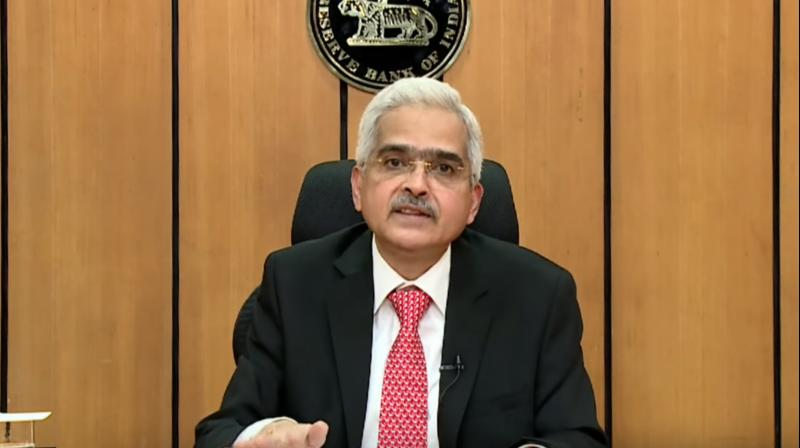
RBI predicts FY23 GDP growth at 7.8%; no change in repo rate
The FY22 inflation is at 5.3%, says Monetary Policy Commitee, predicting CPI inflation for FY23 at 4.5% assuming normal monsoon

Reserve Bank of India Governor Shaktikanta Das on Thursday projected India’s economic growth for the financial year 2022-23 (FY23) at 7.8 per cent. Further, the Monetary Policy Committee (MPC) has kept the benchmark lending rate, or repo rate, unchanged at 4 per cent for the 10th time in a row.
“Notwithstanding a highly transmissible third wave driven by the Omicron variant of COVID-19, India is charting a different course of recovery from the rest of the world,” said Das in a statement. “India is poised to grow at the fastest pace year-on-year among major economies, according to projections made by the International Monetary Fund (IMF). This recovery is supported by large-scale vaccination and sustained fiscal and monetary support.”
Also read: If virus deigns to retreat, Budget 2022-23 would foster growth recovery
The MPC held its meeting from February 8-10 and, “based on an assessment of the current macroeconomic situation and the outlook”, voted to keep the policy repo rate unchanged at 4%. The rate has been retained at that level since May 2020, the early days of the pandemic.
Accommodative stance
“The MPC decided by a majority of 5 to 1 to continue with the accommodative stance as long as necessary to revive and sustain growth on a durable basis and continue to mitigate the impact of COVID-19 on the economy, while ensuring that inflation remains within the target going forward,” said an RBI statement. The marginal standing facility (MSF) rate and the bank rate remain unchanged at 4.25 per cent, while the reverse repo rate, also unchanged, is at 3.35 per cent.
The economy has recovered to pre-COVID levels, said Das. “Real GDP growth at 9.2 per cent for 2021-22 takes it modestly above the level of GDP in 2019-20. Private consumption, the mainstay of domestic demand, continues to trail its pre-pandemic level. The persistent increase in international commodity prices, surge in volatility of global financial markets and global supply bottlenecks can exacerbate risks to the outlook,” he said.
Also read: FM’s budget numbers for capex don’t add up, Crisil confirms
However, he remained optimistic on the year ahead, saying the Centre’s thrust on capital expenditure and exports will likely enhance productive capacity and boost aggregate demand. “Overall, there is some loss of the momentum of near-term growth while global factors are turning adverse. Looking ahead, domestic growth drivers are gradually improving,” he said. “Considering all these factors, real GDP growth is projected at 7.8 per cent for 2022-23.”
Omicron effect on economy
The MPC flagged some potential downside risks to economic activity from Omicron, noted Das. While the Omicron infection has been relatively mild, there has been some loss of momentum in economic activity, he added. This is reflected in high-frequency indicators such as purchasing managers’ indices for both manufacturing and services, finished steel consumption and sales of tractors, two wheelers and passenger vehicles, said the RBI Governor.
“Going forward, positive impulses for quickening the pace of recovery emanate from buoyant rabi prospects, robust export demand, accommodative monetary and liquidity conditions, improving credit offtake, and the continued push on capital expenditure and infrastructure in the Union Budget 2022-23,” said Das.
Inflation expected to improve
Discussing the increase in inflation in December, Das said it was “entirely due to unfavourable base effects despite month-on-month decline in prices”. “Large buffer stocks of cereals and effective supply side measures augur well for food inflation. Core inflation remains elevated, but demand-pull pressures are still muted. The renewed surge in international crude oil prices, however, needs close monitoring,” he observed.
The MPC said that since its December 2021 meeting, CPI inflation has moved along the expected trajectory. “Going forward, vegetable prices are expected to ease further on fresh winter crop arrivals,” it said. “The softening in pulses and edible oil prices is likely to continue in response to strong supply-side interventions by the government and increase in domestic production.”
The inflation projection for FY22 is retained at 5.3 per cent, said the MPC, adding that for Q4 FY22 it is 5.7 per cent. “On the assumption of a normal monsoon in 2022, CPI inflation for 2022-23 is projected at 4.5 per cent,” it said.


